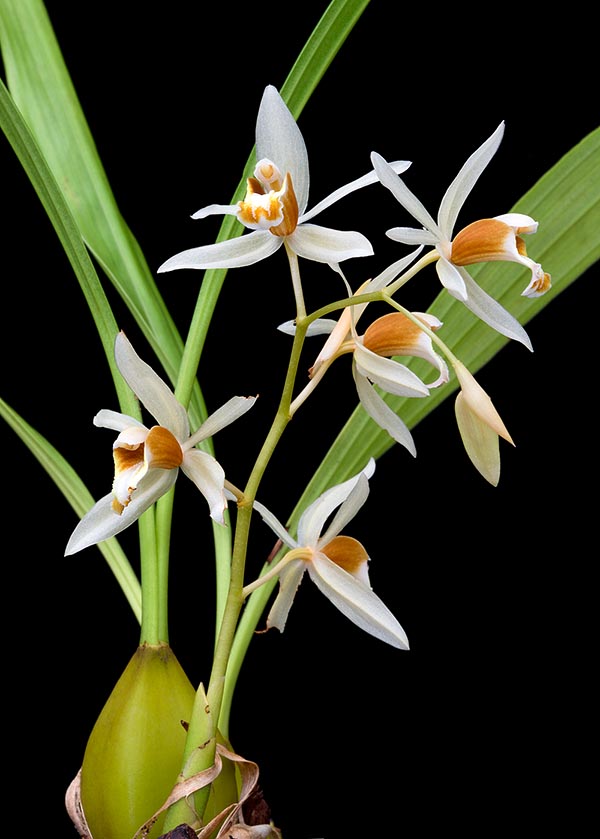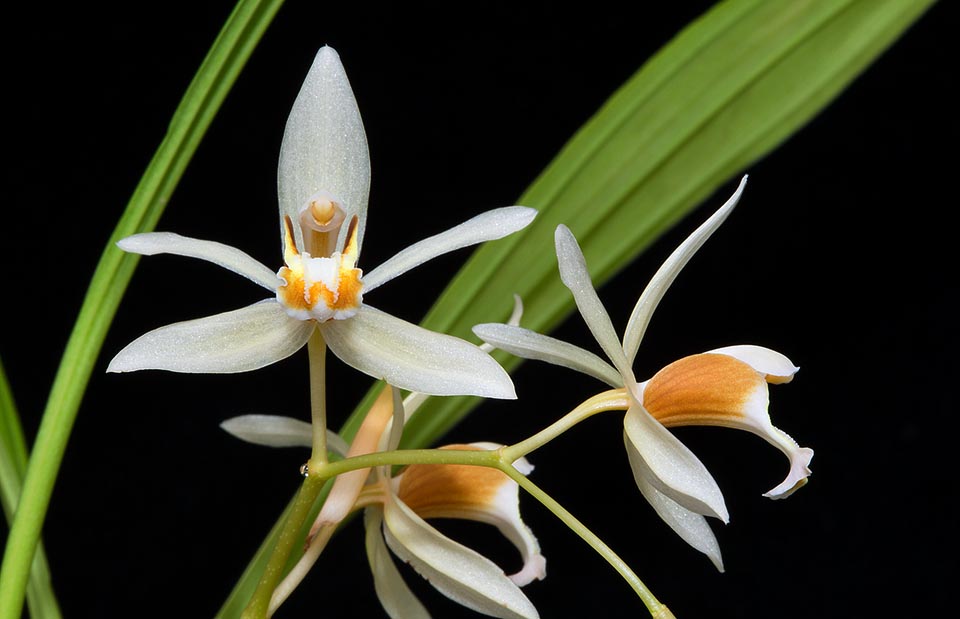Family : Orchidaceae

Text © Pietro Puccio

English translation by Mario Beltramini

Native to South-East Asia, Coelogyne trinervis is an epiphyte, rarely lithophyte © Giuseppe Mazza
The name of the genus is the combination of the Greek adjective “κοῖλος” (koilos) = hollow and of the substantive “γυνή” (gyne) = female, with reference to the concave stigma; the specific Latin name “trinervis” refers to the three ribs on the leaves.
Common names: lan thanh đạm ba gân (Vietnamese).
The Coelogyne trinervis Lindl. (1830) is an epiphytic herbaceous species, occasionally lithophytic, with ovoidal pseudobulbs grooved of yellowish green colour, spaced 2-3 cm on a creeping rhizome, 6-9 cm long and 2-3 cm broad, with at the apex two lanceolate leaves, 25-40 cm long and 2,5-3,5 cm broad, with three prominent ribs.
Terminal inflorescence from the emerging vegetation, initially erect then curved, 13-18 cm long, bearing up to 6-7 flowers, of 3,5-4,5 cm of diameter, that open at the same time, with sepals and petals of white colour, cream or pale greenish yellow and labellum with pale brown lateral lobes and white central lobe with pale brown spots at the apex.
Lanceolate sepals with pointed apex, 2-2,5 cm long and 0,6 cm broad, spatulate-linear petals, 2,2 cm long and 0,3 cm broad, trilobed labellum, 2 cm long and 1,2 cm broad, with roundish lateral lobes and oblong central lobe with obtuse apex and slightly waved margin run by two slightly waved keels, and 1,4 cm long column.
It reproduces by seed, in vitro, and by division, with each section provided of at least of 3-4 pseudobulbs.
Floriferous species and of easy cultivation requires a semi-shaded position, medium-high temperatures, 20-30 °C in summer, slightly lower in winter, with lowest night values not under the 14 °C, high humidity, 60-80%, and a slight constant ventilation. The waterings must be frequent and abundant during the growth, but allowing the substratum to dry up before giving water again, spaced, but without ever letting the compost dry for long time, in winter, utilizing rain water, demineralized or by reverse osmosis; the stagnations of water on the emerging vegetation must be avoided.

Easy to cultivate, has 6-9 cm pseudobulbs with 2 leaves of 25-40 cm. Much apreciated due to the elegant 13-18 cm inflorescences with 6-7 flowers up to 4,5 cm broad © Giuseppe Mazza
Synonyms: Coelogyne cinnamomea Lindl. (1858); Coelogyne rhodeana Rchb.f. (1867); Coelogyne rossiana Rchb.f. (1884); Pleione rossiana (Rchb.f.) Kuntze (1891); Pleione trinervis (Lindl.) Kuntze (1891); Coelogyne angustifolia Ridl. (1897); Coelogyne pachybulbon Ridl. (1897); Coelogyne wettsteiniana Schltr. (1920); Coelogyne stenophylla Ridl. (1924).
→ For general notions about ORCHIDACEAE please click here.
